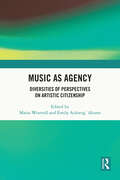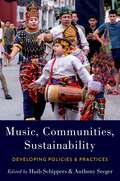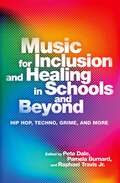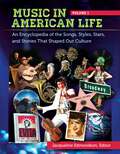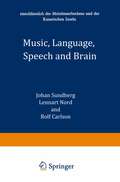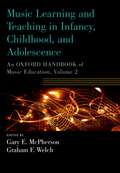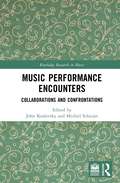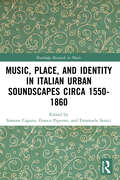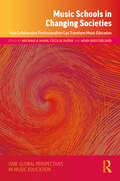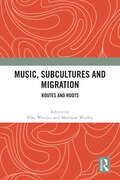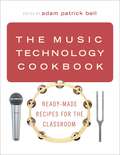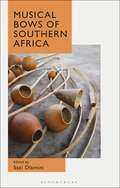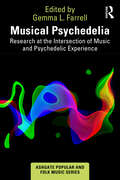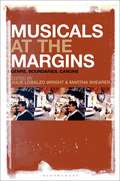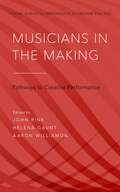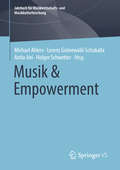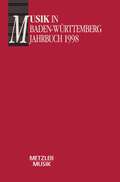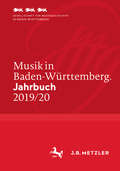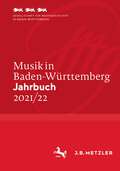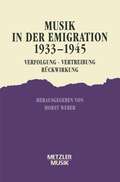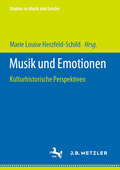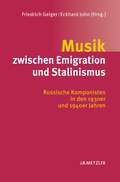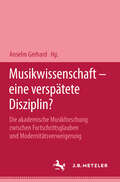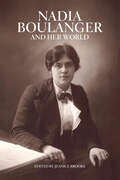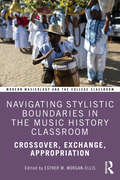- Table View
- List View
Music as Agency: Diversities of Perspectives on Artistic Citizenship
Music as Agency: Diversities of Perspectives on Artistic Citizenship focuses on the concept, application, interpretation and manifestation of Artistic Citizenship in diverse contexts. The key concepts that the book tackles are: Cultural experience, artistic practice, musical identities, equity, democracy, community, activism, resistance and empathy.In giving an overview of aspects of the compound concept of artistic citizenship, Akuno and Westvall present the outcome of research and interrogation of practice by a global network of educator-researchers from Africa, the Americas, Asia and Europe. The book articulates notions of artistic citizenship, coming up with the term artizenship as a derivative of the composite term. It further explains and analyses practical ways of perceiving and relating to art spaces, art practices and arts objects towards belonging, being and becoming in a global space that is disparate, polarised and often alienating, and thus responding to issues such as social justice, identity, participation and inclusion. With a focus on music, the book targets musicians, scholars, educators and enthusiasts keen on gaining a deeper understanding of how music and musicking can influence human interactions towards social integration, trust, cultural awareness and intercultural understanding.
Music, Communities, Sustainability: Developing Policies and Practices
Music, Communities, Sustainability, edited thoughtfully by Huib Schippers and Anthony Seeger, traces the genesis, implementation, and development of the influential 2003 UNESCO Convention on Safeguarding of the Intangible Cultural Heritage and its impact on music practices around the world. With insights from established and emerging scholars who have been there from the early beginnings to those who work with it in communities today, this book tells a riveting story that celebrates the rise in awareness that approaching music as Intangible Cultural Heritage has brought. At the same time, it critiques the discrepancies between ideologies and realities as they emerged across the globe in its first twenty years, and provides perspectives for sound futures for the planet. Gathering such varied perspectives, this essential volume tells a crucial history and expands our understanding of the possibilities and limitations of interventions in music sustainability on a global scale.
Music for Inclusion and Healing in Schools and Beyond: Hip Hop, Techno, Grime, and More
Contemporary popular musics such as hip hop, techno, grime, EDM, drill, house and so on are among the most listened to in the world and yet, typically, they are barely covered in the music classroom if at all. This needs to be better reflected in educational, cultural, and social terms. In wider society, these musics are often treated as if they are the causative for the social dysfunction that, in fact, they merely reflect. At the same time, projects, programmes and practices of such contemporary popular musics can and have supported wellness and healing. Editors Pete Dale, Pamela Burnard, and Raphael Travis Jr. argue that there is huge potential here for enhanced inclusion. Music for Inclusion and Healing in Schools and Beyond explains that when this music is included in the school curriculum or utilised in therapeutic contexts, huge leaps in healing and wellness can be achieved, as well as educational attainment and enjoyment in school contexts. This unique book seeks to account for those positive impacts, theorise them and help to extend and advance their impact. Contributing authors invite readers to re-think the possibilities and potentials for contemporary popular musics to gain the prestige that their actual popularity would suggest they should already command. The various contributors of this book are from diverse ethnic, social and academic backgrounds, and this title includes several chapters from practitioners who have not written about the work they do before now. Readers will learn not only about the impact of projects that utilize such music but also ideas about how that impact can best be measured.
Music in American Life [4 volumes]: An Encyclopedia of the Songs, Styles, Stars, and Stories That Shaped Our Culture [4 volumes]
A fascinating exploration of the relationship between American culture and music as defined by musicians, scholars, and critics from around the world.Music has been the cornerstone of popular culture in the United States since the beginning of our nation's history. From early immigrants sharing the sounds of their native lands to contemporary artists performing benefit concerts for social causes, our country's musical expressions reflect where we, as a people, have been, as well as our hope for the future. This four-volume encyclopedia examines music's influence on contemporary American life, tracing historical connections over time.Music in American Life: An Encyclopedia of the Songs, Styles, Stars, and Stories That Shaped Our Culture demonstrates the symbiotic relationship between this art form and our society. Entries include singers, composers, lyricists, songs, musical genres, places, instruments, technologies, music in films, music in political realms, and music shows on television.
Music, Language, Speech and Brain: Proceedings of an International Symposium at the Wenner-Gren Center, Stockholm, 5–8 September 1990
Speech/language and music are the two main forms of systematic human communication using acoustic signals. This implies that there are interesting and thought-provoking parallels between these areas, which may contribute towards our understanding of the processing and perception of auditory signals. This book reviews the relevant research fields, and includes speech and music examples on CD to help the reader to appreciate the sound characteristics discussed. Areas covered are: descriptions of music and language; speech and music performance; voice and instruments; cognition and perception; neurophysiology; combining speech and music.
Music Learning and Teaching in Infancy, Childhood, and Adolescence: An Oxford Handbook of Music Education, Volume 2 (Oxford Handbooks)
Music Learning and Teaching in Infancy, Childhood, and Adolescence is one of five paperback books derived from the foundational two-volume Oxford Handbook of Music Education. Designed for music teachers, students, and scholars of music education, as well as educational administrators and policy makers, the second book in this set explores a broad array of key issues, concepts, and debates related to music learning and teaching in three phases of a child's development. The first section provides an expanded view of infancy and early childhood, embracing a key theme that most young children's early music-making is improvised and used to communicate with others and the self. These chapters demonstrate the importance of "motherese" or "parentese" to young children's overall development, the extraordinary diversity and richness of children's early musical engagement, and how this can be viewed as a resource for further learning. The second section is devoted to the learning and teaching of music during the middle years of childhood, when music is often a mandated part of the school curriculum. While recognizing the enormous cultural and national differences, chapters in this section give an overview of many varied and innovative forms of musical learning and teaching globally. The authors address issues related to the types of teachers who provide music instructions to children internationally, how they were educated and trained, and how various nations organize their curriculum in ways that provide children with access and opportunities to engage with music in the classroom. The third section focuses on the musical experiences and development of adolescents aged 12 to 18. These chapters explore the role of music in the lives of young people-including how they use and relate to music, how music educators can best meet students' needs, and the types of musical engagement that can either empower or disempower students through involvement in school music. Contributors Mayumi Adachi, Randall Everett Allsup, Janet R. Barrett, Margaret S. Barrett, Brydie-Leigh Bartleet, Lily Chen-Hafteck, Richard Colwell, Sharon G. Davis, George M. DeGraffenreid, Steven C. Dillon, Magne I. Espeland, Martin Fautley, Eve Harwood, Lee Higgins, Beatriz Ilari, Neryl Jeanneret, Chee-Hoo Lum, Stephen Malloch, Esther Mang, Kathryn Marsh, Gary E. McPherson, Oscar Odena, Chris Philpott, S. Alex Ruthmann, Eric Shieh, Gary Spruce, Johannella Tafuri, Sandra E. Trehub, Colwyn Trevarthen, Kari K. Veblen, Graham F. Welch, Heidi Westerlund, Jackie Wiggins, Ruth Wright, Susan Young
Music Performance Encounters: Collaborations and Confrontations (Routledge Research in Music)
Why do most musical performers and musical researchers continue to inhabit divergent epistemic spaces? To what extent is the act of musical performance coextensive with the act of doing musical research, and vice versa? At what point in the research process can a performative act transform into a scholarly one, and a scholarly act into a performative one? These, and other related questions, form the central focus of this book, with each chapter offering a fresh perspective on a particular topic in music performance studies: improvisational traditions, historical performance practices, analysis and performance, sports psychology, cross-cultural musical interactions, and institutional challenges. This book is aimed at music researchers, teachers, students, and practising musicians interested in the intersection of academic and performance research; as such, it seeks to bridge the divide between the research of university-trained musicologists, scholars from other fields who focus on music, and the growing community of musical artist-researchers. Material in this book is supported by performance outcomes offered by the contributors on a separate YouTube channel and on the Routledge online portal.
Music, Place, and Identity in Italian Urban Soundscapes circa 1550-1860 (Routledge Research in Music)
Music, Place, and Identity in Italian Urban Soundscapes circa 1550-1860 presents new perspectives on the role music played in the physical, cultural, and civic spaces of Italian cities from the sixteenth to the nineteenth century. Across thirteen chapters, contributors explore the complex connections between sound and space within these urban contexts, demonstrating how music and sound were intimately connected to changing social and political practices. The volume offers a critical redefinition of the core concept of soundscape, considering musical practices through the lenses of territory, space, representation, and identity, in five parts: Soundscape, Phonosphere, and Urban History Urban Soundscapes across Time Urban Soundscapes and Acoustic Communities Urban Soundscapes in Literary Sources Reconstructing Urban Soundscapes in the Digital Era Music, Place, and Identity in Italian Urban Soundscapes circa 1550-1860 reframes our understanding of Italian music history beyond models of patronage, investigating how sounds and musics have contributed to the construction of human identities and communities.
Music Schools in Changing Societies: How Collaborative Professionalism Can Transform Music Education (ISME Series in Music Education)
Music Schools in Changing Societies addresses the need to understand instrumental and vocal pedagogy beyond the individual sphere of teacher–student interactions and psychological phenomena, focusing instead on the wider sociocultural, spatial, and institutional contexts of music education. Viewing music education through the perspective of collaboration, the book focuses on the context of European music schools, which have developed a central role in publicly funded educational and cultural systems. The authors demonstrate that multilevel collaboration is a vital part of how music educators and the schools where they work can respond to wider societal concerns in ways that improve educational quality. Presenting examples of innovative practices and collaborative settings from twelve European countries, this book offers new and inspiring perspectives on how music schools can support the transformation towards collaborative professionalism in instrumental and vocal music education. With contributions from a wide range of researchers and professional educators, the book shows how a collaborative approach to music education can address major policy issues such as inclusion, democracy, and sustainability. Addressing current institutional and curricular challenges, Music Schools in Changing Societies presents a unique outlook on how music schools in contemporary societies can survive and thrive in times of change.
Music, Subcultures and Migration: Routes and Roots
This edited volume concentrates on the period from the 1940s to the present, exploring how popular music forms such as blues, disco, reggae, hip hop, grime, metal and punk evolved and transformed as they traversed time and space. Within this framework, the collection traces how music and subcultures travel through, to and from democracies, autocracies and anocracies.The chosen approach is multidisciplinary and deliberately diverse. Using both archival sources and oral testimony from a wide variety of musicians, promoters, critics and members of the audience, contributors from a range of academic disciplines explore music and subcultural forms in countries across Asia, Europe, Oceania, North America and Africa. They investigate how far the meaning of music and associated subcultures change as they move from one context to another and consider whether they transcend or blur parameters of class, race, gender and sexuality.
The Music Technology Cookbook: Ready-Made Recipes for the Classroom
Featuring 56 lessons by 49 music technology experts from around the world, The Music Technology Cookbook is an all-in-one guide to the world of music technology, covering topics like: composition (with digital audio workstations such as Ableton, Soundtrap, GarageBand); production skills such as recording, editing, and equalization; creating multimedia (ringtones, soundscapes, audio books, sonic brands, jingles); beatmaking; DJing; programming (Minecraft, Scratch, Sonic Pi, P5.js); and, designing instruments (MaKey MaKey). Each lesson tailored for easy use and provides a short description of the activity, keywords, materials needed, teaching context of the contributing author, time required, detailed instructions, modifications for learners, learning outcomes, assessment considerations, and recommendations for further reading. Music educators will appreciate the book's organization into five sections--Beatmaking and Performance; Composition; Multimedia and Interdisciplinary; Production; Programming--which are further organized by levels beginner, intermediate, and advanced. Written for all educational contexts from community organizations and online platforms to universities and colleges, The Music Technology Cookbook offers a recipe for success at any level.
Musical Bows of Southern Africa
Musical Bows of Southern Africa brings together current scholarly research that documents a rich regional diversity as well as cultural relationships in bow music knowledge and contemporary practices. The book is framed as a critical appraisal of traditional ethnomusicological studies of the region – complementing pioneering studies and charting contexts for a contemporary engagement with bow music as an exchangeable cultural practice. Each contribution is written by an expert in the field and collectively demonstrates the multidisciplinary potential of bow music, highlighting the several fields of knowledge that intersect with bow music including ethno-organology, applied ethnomusicology, composition, music literacy, social development, cultural economics, history, orality, performance and language.
Musical Psychedelia: Research at the Intersection of Music and Psychedelic Experience (Ashgate Popular and Folk Music Series)
Psychedelic music is a fascinating yet under-researched field of study. This thought-provoking collection offers a broad introduction to the fi eld of psychedelic music studies, bringing together scholarly work on psychedelic music in genres like rock, folk, electronic dance music and pop. Through an expanded purview on psychedelic music, an emerging trend in research, the collection affords students and academics alike an introduction to a rich, multi-faceted field. The contributing authors explore a range of different facets of musical psychedelia: its transgressive and transcendent aspects, its foregrounding of timbre and texture, the way it changes our perception of time, its influence on “non-psychedelic” music, key composition and production techniques that composers and musicians use in its creation, how it is mediated by different places and spaces, and the interplay between psychedelic visual and sonic aesthetics. This interdisciplinary work reveals both commonalities in musical psychedelic experiences and the contestation inherent in a fi eld of study that juxtaposes music of different genres and eras with a variety of theoretical approaches and methodologies. In broadening the scope of psychedelic music research, the collection not only makes for varied and absorbing reading on the subject level but also stimulates reflexive thought about interdisciplinary research.
Musicals at the Margins: Genre, Boundaries, Canons
But is it a musical? This question is regularly asked of films, television shows and other media objects that sit uncomfortably in the category despite evident musical connections. Musicals at the Margins argues that instead of seeking to resolve such questions, we should leave them unanswered and unsettled, proposing that there is value in examining the unstable edges of genre. This collection explores the marginal musical in a diverse range of historical and global contexts. It encompasses a range of different forms of marginality including boundary texts (films/media that are sort of/not quite musicals), musical sequences (marginalized sequences in musicals; musical sequences in non-musicals), music films, musicals of the margins (musicals produced from social, cultural, geographical, and geopolitical margins), and musicals across media (television and new media). Ultimately these essays argue that marginal genre texts tell us a great deal about the musical specifically and genre more broadly.
Musicians in the Making: Pathways to Creative Performance (Studies in Musical Performance as Creative Practice)
Musicians are continually 'in the making', tapping into their own creative resources while deriving inspiration from teachers, friends, family members and listeners. Amateur and professional performers alike tend not to follow fixed routes in developing a creative voice: instead, their artistic journeys are personal, often without foreseeable goals. The imperative to assess and reassess one's musical knowledge, understanding and aspirations is nevertheless a central feature of life as a performer. Musicians in the Making explores the creative development of musicians in both formal and informal learning contexts. It promotes a novel view of creativity, emphasizing its location within creative processes rather than understanding it as an innate quality. It argues that such processes may be learned and refined, and furthermore that collaboration and interaction within group contexts carry significant potential to inform and catalyze creative experiences and outcomes. The book also traces and models the ways in which creative processes evolve over time. Performers, music teachers and researchers will find the rich body of material assembled here engaging and enlightening. The book's three parts focus in turn on 'Creative learning in context', 'Creative processes' and 'Creative dialogue and reflection'. In addition to sixteen extended chapters written by leading experts in the field, the volume includes ten 'Insights' by internationally prominent performers, performance teachers and others. Practical aids include abstracts and lists of keywords at the start of each chapter, which provide useful overviews and guidance on content. Topics addressed by individual authors include intrapersonal and interpersonal dynamics, performance experience, practice and rehearsal, 'self-regulated performing', improvisation, self-reflection, expression, interactions between performers and audiences, assessment, and the role of academic study in performers' development.
Musik & Empowerment (Jahrbuch für Musikwirtschafts- und Musikkulturforschung)
Der Band behandelt die Verbindung von Musik, Wirtschaft und Empowerment, verstanden als die Möglichkeit des Sichtbarwerdens marginalisierter oder relativ machtloser, subalterner Gruppen und allgemein die Frage von Macht und Ausschluss in Musikkulturen und am Musikmarkt. Dies betrifft unter anderem (aber nicht ausschließlich) die momentan stark diskutierten Themenfelder Gender und Diversität. Wie sehen diese Verbindungen aktuell und historisch aus? Kann auch heute noch davon ausgegangen werden, dass allein die Teilnahme an Gruppenprozessen bereits einen wesentlichen Motor für das Entstehen eines Ermächtigungsgefühls darstellt? Oder geht es aus individueller Perspektive stärker darum, Einzelnen mehr Kontrolle über ihr Leben zu ermöglichen? Beide Aspekte werden durch Beiträge in diesem Buch in Form von Studien, aber auch in individuellen Standpunkten und Innenansichten zur Musikwirtschaft und Musikkultur beleuchtet.
Musik in Baden-Württemberg, Band 5: Jahbuch 1998
1898, vor hundert Jahren, wurde an der Universität Heidelberg mit Philipp Wolfrum der erste Professor für Musikwissenschaft im Gebiet des heutigen Bundeslandes Baden-Württemberg berufen. Aus diesem Anlaß befassen sich vier Beiträge in diesem Jahrbuch mit der Geschichte der musikwissenschaftlichen Lehre in Baden und Württemberg: Thomas Schipperges mit Heidelberg, Michael Kaufmann mit Karlsruhe, Eckhard John mit der Freiburger Ära Wilibald Gurlitts sowie Gabriela Rothmund-Gaul mit dem Amt des Tübinger Universitätsmusikdirektors. Es folgen Beiträge zu regionalgeschichtlich bedeutenden Komponisten: Hans-Bruno Ernst beschäftigt sich mit Josef Anton Laucher (1737-1813); Clytus Gottwald mit Joseph Huber (1837-1886), der zur selben Zeit wie Wagner eine eigenständige musikdramatische Form entwickelte; Lee A. Rothfarb mit August Halm (1869-1929) sowie Paul Feuchte mit dem Heidelberger Richard Franck. Neben weiteren Aufsätzen enthält der Band, wie stets, die Musikbibliographie Baden-Württemberg, die Rubrik Neue und restaurierte Orgeln" sowie einen umfangreichen Rezensionsteil zu Neuerscheinungen."
Musik in Baden-Württemberg. Jahrbuch 2019/20: Band 25 (Musik in Baden-Württemberg. Jahrbuch)
Der vorliegende Doppeljahrgang ist ein Abbild der reichen und vielfältigen Musikkultur Baden-Württembergs. Die geschichtliche Bandbreite reicht vom 17. Jahrhundert bis in die Gegenwart. Insgesamt 29 Autorinnen und Autoren haben zur mehrhundertjährigen Musikgeschichte des Landes wissenschaftliche und populärwissenschaftliche Beiträge geschrieben. Die beiden thematischen Schwerpunkte des Jahrgangs präsentieren unterschiedlichste Aspekte zum Kosmos Lied sowie Jubiläen und Gedenktage von Musikerpersönlichkeiten und Institutionen, die in Verbindung mit Baden-Württemberg stehen oder gestanden haben.
Musik in Baden-Württemberg. Jahrbuch 2021/22: Band 26 (Musik in Baden-Württemberg. Jahrbuch)
Der 26. Band des Jahrbuches zur Musik in Baden-Württemberg enthält aktuelle Forschungsbeiträge und populärwissenschaftliche Artikel zur reichen und vielfältigen Musikkultur des Landes. Die beiden thematischen Schwerpunkte des Jahrbuchs präsentieren eine Auswahl von Musikfestivals in Baden-Württemberg sowie regionale Aspekte zu Leben und Werk der Komponistinnen Pauline Viardot-Garcìa, Luise Adolpha Le Beau und Clara Faisst.
Musik und Emotionen: Kulturhistorische Perspektiven (Studien zu Musik und Gender)
Musik und Emotionen haben Konjunktur, und zwar nicht erst seit Emotionen in Wissenschaft, Ratgeberliteratur und Journalismus zu einem der Hauptthemen geworden sind. Die Verbindung zwischen diesen beiden ephemeren Phänomenen geht bis in die Antike zurück, und sie ist weit komplexer als es die weitläufig bekannte Formulierung, Musik sei die Sprache der Gefühle, erahnen lässt. Im vorliegenden Band werden zum ersten Mal Herangehensweisen aus der Historischen Musikwissenschaft, der Tanzwissenschaft und den Sound Studies mit Ansätzen aus der Emotionsgeschichte verbunden, um den vielschichtigen Zusammenhang zwischen Musik und Emotionen aus einer kulturhistorischen Perspektive zu beschreiben.
Musik zwischen Emigration und Stalinismus: Russische Komponisten in den 1930er und 1940er Jahren
Russisches Musikleben nach der Oktoberrevolution 1917. Während zahlreiche Komponisten vor Stalin ins Ausland flohen, darunter Rachmaninow und Strawinsky, blieben andere im Land und etablierten dort eine eigene Traditionslinie. Der Band widmet sich erstmals umfassend der Spaltung der russischen Musikkultur. Als Schlüsselfigur der Zeit zwischen 1930 und 1950 entpuppt sich dabei Prokofjew, der in die Sowjetunion zurückkehrte und beide Musikkulturen in sich vereinte.
Musikwissenschaft - eine verspätete Disziplin?: Die akademische Musikforschung zwischen Fortschrittsglauben und Modernitätsverweigerung
Kontroverse um die moderne Musikforschung. Mit dem Band stellt sich die Musikwissenschaft erstmals kritisch ihrer eigenen Geschichte, die über die kulturkonservative Ideologie bruchlos in die "völkischen" Verstrickungen während des Dritten Reiches mündete.
Nadia Boulanger and Her World (Bard Music Festival)
Nadia Boulanger (1887–1979) was arguably one of the most iconic figures in twentieth-century music, and certainly among the most prominent musicians of her time. For many composers— especially Americans from Aaron Copland to Philip Glass—studying with Boulanger in Paris or Fontainebleau was a formative moment in a creative career. Composer, performer, conductor, impresario, and charismatic and inspirational teacher, Boulanger engaged in a vast array of activities in a variety of media, from private composition lessons and lecture-recitals to radio broadcasts, recordings, and public performances. But how to define and account for Boulanger’s impact on the music world is still unclear. Nadia Boulanger and Her World takes us from a time in the late nineteenth century, when many careers in music were almost entirely closed to women, to the moment in the late twentieth century when those careers were becoming a reality. Contributors consider Boulanger’s work in the worlds of composition, musical analysis, and pedagogy and explore the geographies of transatlantic and international exchange and disruption within which her career unfolded. Ultimately, this volume takes its title as a topic for exploration—asking what worlds Boulanger belonged to, and in what sense we can consider any of them to be “hers.”
Navigating Stylistic Boundaries in the Music History Classroom: Crossover, Exchange, Appropriation (Modern Musicology and the College Classroom)
At a time of transformation in the music history classroom and amid increasing calls to teach a global music history, Navigating Stylistic Boundaries in the Music History Classroom adds nuance to the teaching of varied musical traditions by examining the places where they intersect and the issues of musical exchange and appropriation that these intersections raise. Troubling traditional boundaries of genre and style, this collection of essays helps instructors to denaturalize the framework of Western art music and invite students to engage with other traditions—vernacular, popular, and non-Western—on their own terms.The book draws together contributions by a wide range of active scholars and educators to investigate the teaching of music history around cases of stylistic borders, exploring the places where different practices of music and values intersect. Each chapter in this collection considers a specific case in which an artist or community engages in what might be termed musical crossover, exchange, or appropriation and delves deeper into these concepts to explore questions of how musical meaning changes in moving across worlds of practice. Addressing works that are already widely taught but presenting new ways to understand and interpret them, this volume enables instructors to enrich the perspectives on music history that they present and to take on the challenge of teaching a more global music history without flattening the differences between traditions.
